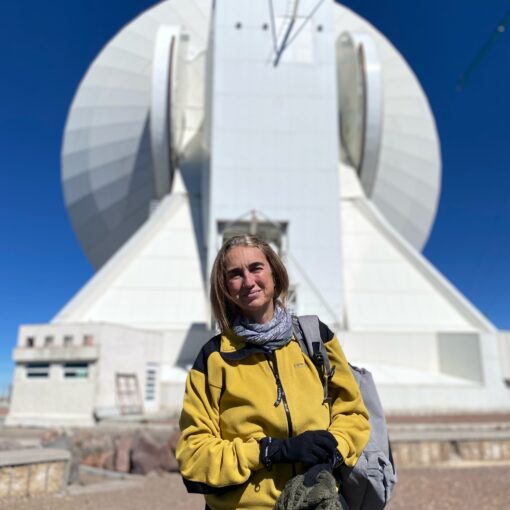Also available in: Español (Spanish) Euskara (Basque)
Jiménez-Andrade, E. F.; Zavala, J. A.; Magnelli, B.; Casey, C. M.; Liu, D.; Romano-Díaz, E.; Schinnerer, E.; Harrington, K.; Aretxaga, I.; Karim, A.; Staguhn, J.; Burnham, A. D.; Montaña, A.; Smolčić, V.; Yun, M.; Bertoldi, F.; Hughes, D.
Accepted for publication in Astrophysical Journal (arXiv: 2001.06997)
We combine observations from the Atacama Large Millimeter/submillimeter Array (ALMA) and the NOrthern Extended Millimeter Array (NOEMA) to assess the redshift and to study the star formation conditions in AzTEC2: one of the brightest sub-millimeter galaxies (SMGs) in the COSMOS field (S1.1mm = 10.5 ± 1.4 mJy). Our high-resolution observations confirm that AzTEC2 splits into two components (namely AzTEC2-A and AzTEC2-B) for which we detect [C II] and 12CO(5→4) line emission, implying a redshift of 4.626±0.001 (4.633±0.001) for AzTEC2-A (AzTEC2-B) and ruling out previous associations with a galaxy at z ∼ 1. We use the 12CO(5→4) line emission and adopt typical SMG-like gas excitation conditions to estimate the molecular gas mass, which is Mgas(αCO/2.5) =2.1 ± 0.4 × 1011 M sun for AzTEC2-A, and a factor four lower for AzTEC2-B. With the infrared-derived star formation rate of AzTEC2-A (1920±100 Msun yr−1) and AzTEC2-B (710±35 M sun yr−1), they both will consume their current gas reservoir within (30−200) Myr. We find evidence of a rotation-dominated [C II] disk in AzTEC2-A, with a de-projected rotational velocity of vrot(i = 39◦) = 660 ± 130 km s−1, velocity dispersion 100 km s−1, and dynamical mass of Mdyn(i = 39◦) = 2.6+1.2−0.9 × 1011 Msun . We propose that an elevated gas accretion rate from the cosmic web might be the main driver of the intense levels of star formation in AzTEC2-A, which might be further enhanced by gravitational torques induced by its minor companion (AzTEC2-B). These results strengthen the picture whereby the population of single-dish selected SMGs is rather heterogeneous, including a population of pairs of massive, highly-active galaxies in a pre-coalescence phase.

- [EN] An explanation of this paper for the general public can be found in the post «What is AzTEC2?
- [ES] La explicación a todo público de este artículo se encuentra en la entrada «¿Qué es AzTEC2»
- [EU] Publiko orokorrarentzako azalpena post honetan: «Zer da AzTEC2?»



